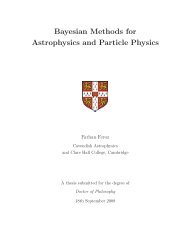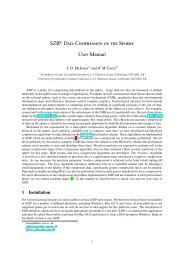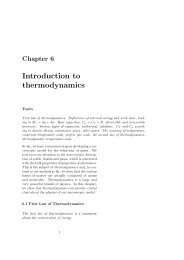Self study guide: Fortran 95 - University of Cambridge
Self study guide: Fortran 95 - University of Cambridge
Self study guide: Fortran 95 - University of Cambridge
Create successful ePaper yourself
Turn your PDF publications into a flip-book with our unique Google optimized e-Paper software.
• Each function starts with the keyword function and ends with<br />
end function and the function name; this is quite like the syntax we have<br />
already met introducing the program itself.<br />
• Notice how within the function the function name is treated like a variable; we<br />
define its type and assign it a value; this is the value returned from the function<br />
and used when the function is called.<br />
• The functions defined in this way are called internal functions since they are<br />
defined within the program itself. We shall see the nature <strong>of</strong> this in a little while.<br />
• Values are supplied to the function via its arguments, i.e. the variables<br />
specified in parentheses (the x in this example); note each argument must have its<br />
type specified.<br />
Enter this program, compile and run it. Try to understand the output. Modify<br />
the functions to some other form to find the roots <strong>of</strong> different functions using<br />
Newton’s method.<br />
5.2 Formal definition<br />
The structure <strong>of</strong> a routine is the same as for a main program, except that the first line<br />
defines the routine name. Thus the form for a function is:<br />
function name(arg1, arg2, ....)<br />
[declarations, including those for the arguments]<br />
[executable statements]<br />
end function [name]<br />
and for a subroutine:<br />
subroutine name(arg1, arg2, ....)<br />
[declarations, including those for the arguments]<br />
[executable statements]<br />
end subroutine [name]<br />
Additionally for functions name must occur in a declaration statement in the function<br />
segment itself. The value the function takes is defined by a statement where name is<br />
assigned a value just like any other variable in the function segment.<br />
The arguments must appear in the declarations as will any local variables; if you<br />
change the value <strong>of</strong> one <strong>of</strong> the arguments then the corresponding variable in the<br />
program “calling” the function or subroutine will also change. For this reason it is<br />
imperative that the type <strong>of</strong> dummy arguments agree with that <strong>of</strong> the variables in the<br />
call <strong>of</strong> the routine.<br />
If you wish to terminate execution <strong>of</strong> a function or subroutine before the last<br />
statement in the subroutine (e.g. you may test some condition with an if clause and<br />
decide there is no more to do) then you can use the return statement to terminate<br />
the routine.<br />
33






